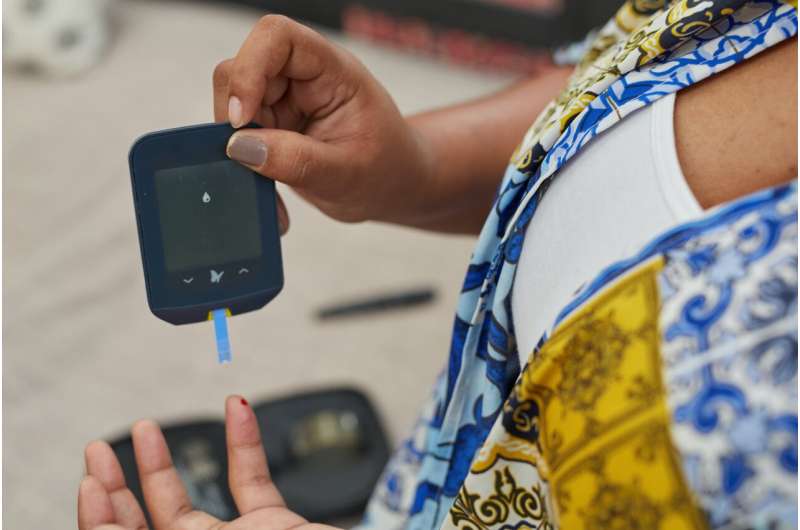This article has been reviewed according to Science X's editorial process and policies. Editors have highlighted the following attributes while ensuring the content's credibility:
fact-checked
trusted source
proofread
Study reveals distinct illness trajectory in the years leading up to type 2 diabetes diagnosis

New research presented at this year's Annual Meeting of The European Association for the Study of Diabetes (EASD), Hamburg (2–6 Oct), reveals a marked increase in several common conditions in the years leading up to, and immediately prior to, type 2 diabetes diagnosis, suggesting considerably earlier diagnosis might be possible in some patients.
"These novel insights into the onset and natural progression of type 2 diabetes, suggest an early phase of inflammation-related disease activity long before any clinical diagnosis of type 2 diabetes is made," says senior author Dr. Adrian Heald from Manchester University, UK.
"These findings hint at the potential for type 2 diabetes to be diagnosed earlier, and we hope that the distinct clinical trajectory could become a predictive tool for people at risk of the disease."
Type 2 diabetes is commonly associated with an increasing complexity of multiple illnesses and related treatments. While some progress has been made in identifying genetic and non-genetic risk factors for type 2 diabetes, understanding the long-term clinical history of individuals before and after diagnosis may provide additional insights into its causes and complex trajectory of multiple health conditions.
To find out more, UK researchers from Manchester Metropolitan University, Manchester University and Salford Royal Hospital analyzed longitudinal data from the Diabetes Alliance for Research in England (DARE) Study to examine the accumulation of the most common clinical conditions in 1,932 adults with and without type 2 diabetes matched by age and gender.
Data on 1,196 individuals who were eventually diagnosed with type 2 diabetes and 736 without diabetes were analyzed over a period of up to 50 years (25 years pre-diagnosis and 25 years post-diagnosis). The average age at type 2 diabetes diagnosis was 53 years.
The trajectory analysis revealed that for individuals eventually diagnosed with type 2 diabetes, a number of common conditions increased consistently in the years leading up to diagnosis, specifically: high blood pressure, respiratory tract infections, heart conditions (i.e., heart failure, heart attack, angina, coronary angioplasty, coronary artery bypass graft, and heart disease), asthma, and eye, nose, and throat infections (e.g., pharyngitis, sinusitis, and conjunctivitis).
Additionally, researchers found that immediately prior to type 2 diabetes diagnosis, more than 1 in 3 individuals experienced high blood pressure and respiratory tract infection, while around 1 in 5 had a heart condition or eye, nose, and throat infection, and 1 in 10 developed asthma.
The corresponding trajectory over time was much less dramatic in those without type 2 diabetes, with fewer than 1 in 20 individuals being diagnosed with any of these conditions, apart from respiratory tract infections that were experienced by around 1 in 10.
After a type 2 diabetes diagnosis, the proportion of individuals experiencing high blood pressure, chronic obstructive pulmonary disease (COPD), retinopathy (a complication of diabetes when the retina is damaged), and infections, climbed rapidly for around 15 years before plateauing. Similarly, both heart conditions and asthma continued to increase in those diagnosed with type 2 diabetes.
"Understanding the long-term clinical history of type 2 diabetes years before diagnosis means that in the future, people could have the time to make lifestyle changes to prevent this lifechanging disease from arising," says co-author Dr. Adrian Heald from Salford Royal Hospital, UK. "This study demonstrates that subacute inflammation which manifests as the onset of hypertension, asthma or an acute infection, regardless of whether it is caused by the genome, demography or comorbidities, may serve as a precursor to the later onset of type 2 diabetes."
He continues, "These observations offer a fascinating and fresh perspective on the beginning and normal development from pre-type 2 diabetes to type 2 diabetes diagnosis and beyond, implying a possible early stage of disease activity that is linked to, but not yet clinically diagnosed as, diabetes. The matter of metabolic control and how this relates to a broad range of treatment factors (pharmacological and non-pharmacological) will be addressed in a future work."
Despite the important findings, this is a small, retrospective observational study and cannot prove causation, and the authors acknowledge that they cannot rule out the possibility that other unmeasured factors may have influenced the results. In addition, the authors note several other limitations, which may have affected the results, including the accuracy of the coding at the level of GP and the potential for bias through misclassification/missing data; that type 2 diabetes is a diverse disorder and the study has not examined all its possible subgroups; and that some multimorbidity may be related to socio-economic deprivation.
More information: Adrian Heald et al, A Longitudinal Clinical Trajectory Analysis Examining the Accumulation of Co-morbidity in People with Type 2 Diabetes (T2D) Compared with Non-T2D Individuals, Diabetes Therapy (2023). DOI: 10.1007/s13300-023-01463-9




















